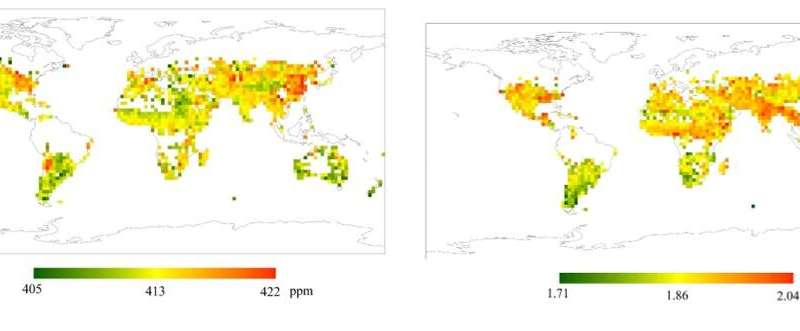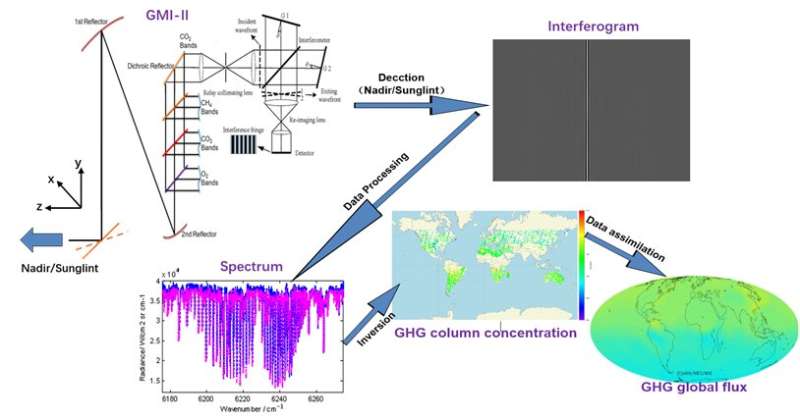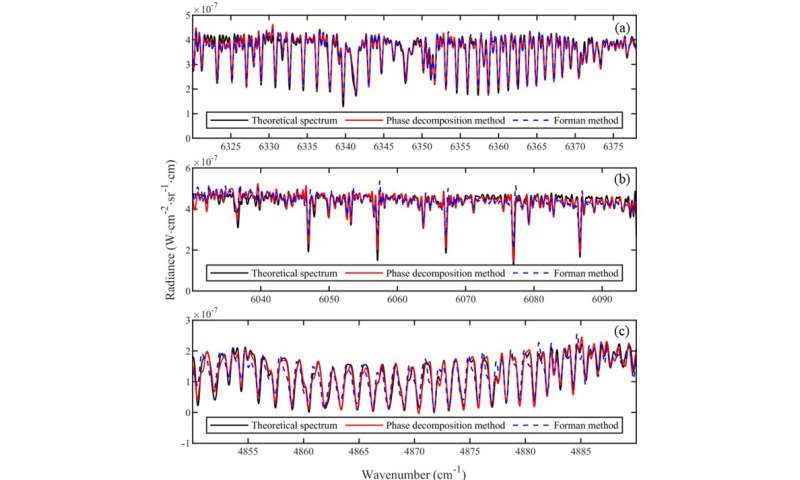Novel algorithm proposed for satellite detection of greenhouse gases
To meet the demand for greenhouse gas detection, a novel phase correction algorithm of interferometric data for the optimally designed Greenhouse gases Monitoring Instrument-II (GMI-II) has been developed by researchers led by Prof. Xiong Wei from the Hefei Institutes of Physical Science (HFIPS) of the Chinese Academy of Sciences (CAS).
Satellite remote sensing is one of the most important means of calibrating global greenhouse gas emission inventories. Trace variations in greenhouse gas concentrations place extremely high demands on the detection accuracy of carbon monitoring payloads. In response to many requirements including high sensitivity, high stability and high timeliness, hyperspectral resolution technology has become an advantageous way to achieve remote sensing detection of greenhouse gases.
Xiong’s team was the first to propose the quantitative monitoring of atmospheric greenhouse gas absorption spectra using spatial heterodyne spectroscopy (SHS). The GMI-II developed using SHS was launched on board the Gaofen-5 satellite-II.
-
![Novel algorithm proposed in greenhouse gases spaceborne detection]()
Figure 2. Correction spectra Comparison of the novel correction algorithm and Forman method that has the best phase correction effect among traditional phase correction methods for each GMI-II channel: (a) CO2-1 channel; (b) CH4 channel; (c) CO2-2 channel. Credit: Wang Qiansheng
-

Global distribution of XCO2 and XCH4 column concentration data from the GMI-II. Credit: Wang Qiansheng
Complex phase distortions occur in the instrument’s observations. Based on the analysis of the distortion mechanism of interferometric data, the team used the monochromatic light interferometric data to first extract and correct the spatial phase distortion inherent in the for the instrument, and then to correct the frequency-dependent phase distortion to achieve high-precision recovery of the target spectra.
The algorithm has been validated using in-orbit observations of the GMI-II. Compared to the conventional phase correction algorithm, it reduces the RMS of the corrected spectrum by 81.37%, which is more accurate.
Related research is published in the journals Remote Sensing and Optics Express.
More information:
Haiyan Luo et al, Greenhouse Gases Monitoring Instrument on GaoFen-5 Satellite-II: Optical Design and Evaluation, Remote Sensing (2023). DOI: 10.3390/rs15041105
Qiansheng Wang et al, Greenhouse gases monitoring instrument on a GF-5 satellite-II: correction of spatial and frequency-dependent phase distortion, Optics Express (2022). DOI: 10.1364/OE.479524
Citation:
Novel algorithm proposed for satellite detection of greenhouse gases (2023, February 28)
retrieved 28 February 2023
from https://phys.org/news/2023-02-algorithm-satellite-greenhouse-gases.html
This document is subject to copyright. Apart from any fair dealing for the purpose of private study or research, no
part may be reproduced without the written permission. The content is provided for information purposes only.

To meet the demand for greenhouse gas detection, a novel phase correction algorithm of interferometric data for the optimally designed Greenhouse gases Monitoring Instrument-II (GMI-II) has been developed by researchers led by Prof. Xiong Wei from the Hefei Institutes of Physical Science (HFIPS) of the Chinese Academy of Sciences (CAS).
Satellite remote sensing is one of the most important means of calibrating global greenhouse gas emission inventories. Trace variations in greenhouse gas concentrations place extremely high demands on the detection accuracy of carbon monitoring payloads. In response to many requirements including high sensitivity, high stability and high timeliness, hyperspectral resolution technology has become an advantageous way to achieve remote sensing detection of greenhouse gases.
Xiong’s team was the first to propose the quantitative monitoring of atmospheric greenhouse gas absorption spectra using spatial heterodyne spectroscopy (SHS). The GMI-II developed using SHS was launched on board the Gaofen-5 satellite-II.
-
![Novel algorithm proposed in greenhouse gases spaceborne detection]()
Figure 2. Correction spectra Comparison of the novel correction algorithm and Forman method that has the best phase correction effect among traditional phase correction methods for each GMI-II channel: (a) CO2-1 channel; (b) CH4 channel; (c) CO2-2 channel. Credit: Wang Qiansheng
-

Global distribution of XCO2 and XCH4 column concentration data from the GMI-II. Credit: Wang Qiansheng
Complex phase distortions occur in the instrument’s observations. Based on the analysis of the distortion mechanism of interferometric data, the team used the monochromatic light interferometric data to first extract and correct the spatial phase distortion inherent in the for the instrument, and then to correct the frequency-dependent phase distortion to achieve high-precision recovery of the target spectra.
The algorithm has been validated using in-orbit observations of the GMI-II. Compared to the conventional phase correction algorithm, it reduces the RMS of the corrected spectrum by 81.37%, which is more accurate.
Related research is published in the journals Remote Sensing and Optics Express.
More information:
Haiyan Luo et al, Greenhouse Gases Monitoring Instrument on GaoFen-5 Satellite-II: Optical Design and Evaluation, Remote Sensing (2023). DOI: 10.3390/rs15041105
Qiansheng Wang et al, Greenhouse gases monitoring instrument on a GF-5 satellite-II: correction of spatial and frequency-dependent phase distortion, Optics Express (2022). DOI: 10.1364/OE.479524
Citation:
Novel algorithm proposed for satellite detection of greenhouse gases (2023, February 28)
retrieved 28 February 2023
from https://phys.org/news/2023-02-algorithm-satellite-greenhouse-gases.html
This document is subject to copyright. Apart from any fair dealing for the purpose of private study or research, no
part may be reproduced without the written permission. The content is provided for information purposes only.

